This post was last updated on December 10th, 2023
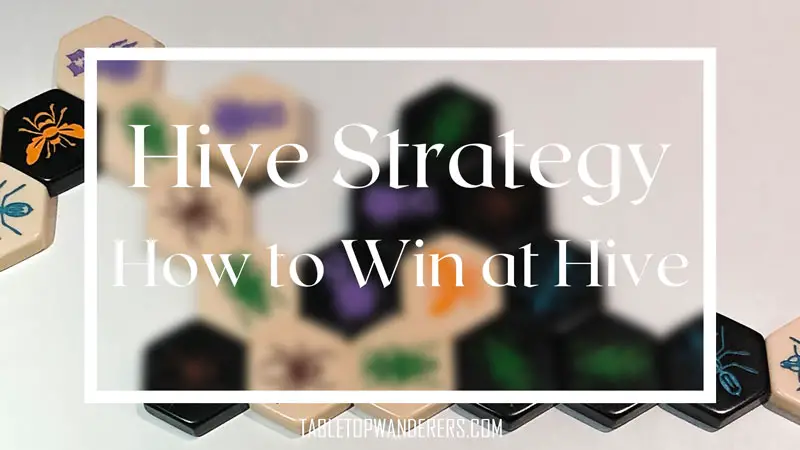
When I first played Hive I didn’t immediately picture it as a deep game; probably all those insects tricked me for good.
I was wrong of course and it didn’t take too long to figure that out. Since the second match, I was deeply in love with that incredible abstract game.
Don’t let me start again… I praised the game enough in my Hive review, so I’ll keep the intro short for everyone’s patience.
If you played the game even once, you have already noticed that there are so many ways to win and if you stumbled across this article it is probably because you were on the hunt to find a good Hive strategy, and you’ve come to the right place.
I’m not a Hive master by all means, but the strategic tips shared here might help you start the game with the right foot and perhaps lead you to a smooth win.
Hive Strategy – Core Concepts and Premises
Before jumping straight into the article let me share with you a few important premises that will integrate my strategy itself.
#1 | Base Game only
This Hive strategy article takes into consideration the base game only, without expansions. I’m not experienced enough to recommend you anything about the new bugs.
I think that you have to master the base game before introducing the expansions anyway.
#2 | When to Play the Queen Bee
One of the core rules of Hive is that you can’t move any pieces until the Queen Bee enters the hive in the first 4 turns.
It’s important to play this important bug as early as you can, I usually play it at the 2nd turn and rarely at the 3rd one. I never wait until the last turn, it’s way too late.
#3| Surrounding the Queen Bee or control the Hive
Surrounding the Queen Bee is the way you win the game, and I have seen a lot of people going after that goal without paying too much attention to controlling the hive and the opponents’ bugs. Big mistake.
Between the two options always go for the second one: controlling the hive is way more important and it will also lead you to win the game.
I always suggest playing slow and with a defensively mentality, before dropping your bombs after you are in control of the board.
#4| How and when is better to use your Ants
Ants are by far the best bug you have in your arsenal, so use it wisely. They should be brought to the game relatively early as they are the best bug to control and pin the opponents’ hexes, giving you the advantage of controlling the board.
Keep them on the outer edge of the Hive and impose your tempo on the game.
Hive Strategy – Starting opening placements (White)
The first section of this article is all about the personal starting strategies that I found to be really good when it comes to opening the game.
I don’t have an exact winning ratio for each of them, unfortunately, so I decided to rank them from the most used to the least used.
Keep in mind that these strategies are for when you play white hexes and you go first.
If you play black it’ll be a bit different and I’ll describe my preferences about that further below.
#1 | Grasshopper – Queen Bee – Ant
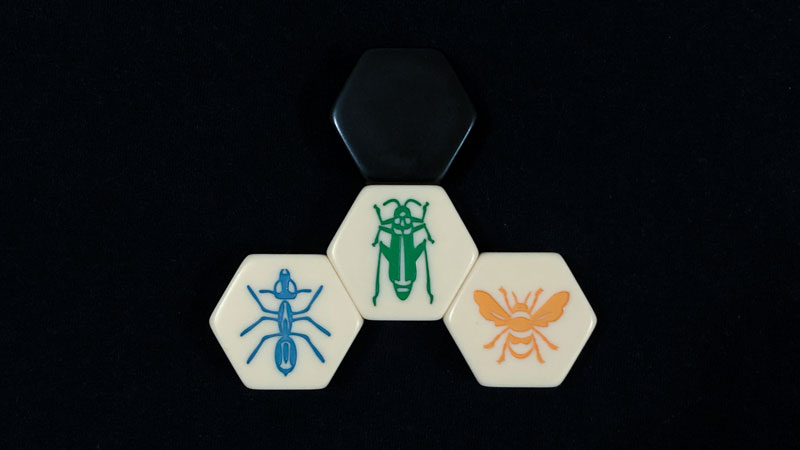
Grasshopper is placed first, followed by the Queen Bee and the Ant in a Y shape placement.
After many matches where I used to open with the Spider, which was considered the weakest insect, I switched to a more defensive bug.
Considering that the first bug you place on the table will almost certainly be locked in that position for the whole game, placing the spider wasn’t the best option as you are just sacrificing it.
Placing a Grasshopper instead means that you have a hex next to the Queen Bee that can be freed up in certain conditions.
#2 | Beetle – Queen Bee – Ant
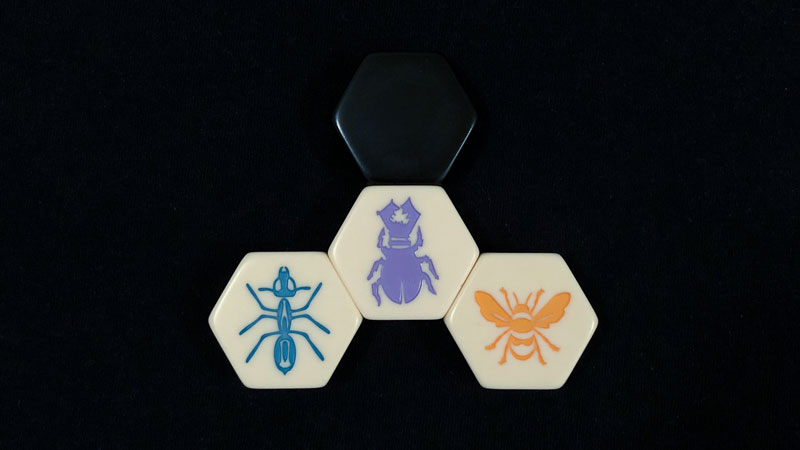
Beetle is placed first, followed by the Queen Bee and the Ant in a Y shape placement.
Very similar to the 1st opening using the Beetle instead of the Grasshopper. I use this variation when I want to change my gameplay a little bit.
In both strategies, I open the game with a defensive bug that hasn’t any movement restrictions even when it’s completely surrounded; the grasshopper can jump out and the beetle can climb on top of the hive.
Take the spider as an example, if you play it as your first bug it is likely to be stuck in that position for the entire game and this could drop your chances to win.
When I discovered the utility of having a defensive bug next to my Queen Bee it was a game-changer.
#3 | Grasshopper – Queen Bee – Ant
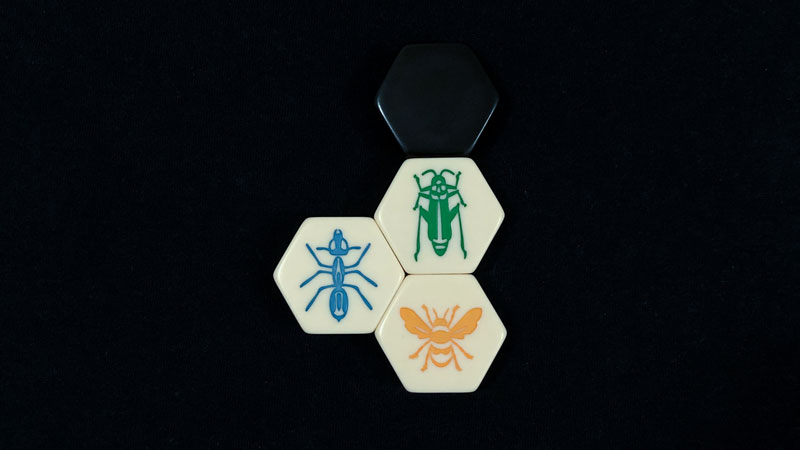
Grasshopper is placed first, followed by the Queen Bee and the Ant in a V shape placement.
For this opening, I use the same bugs as the 1st one but instead of a Y position, I switched to a V position.
This is for two reasons mainly:
- Make more distance between my Queen Bee and the opponent’s one, to have a little bit more freedom while placing my bugs without worrying too much to finish a game with a draw (that I personally dislike!).
- To avoid my Queen Bee to be pinned in a straight line by the opponent’s spider; the Queen Bee will be pinned anyway but with an “elbow” pin, which is way easier to be bypassed.
Hive Strategy – Starting opening placements (Black)
When it comes to opening using black hexes the story is a bit different from what I described above.
Looking at what your opponent places on the table can be beneficial in the matter of deciding which bug you should play next, but as a general tip, playing a defensive bug next to your Queen Bee is still highly recommended.
Same as for the white openings’ strategy, I will describe my favourite opening based on the frequency of how I play them.
#4 | Grasshopper – Queen Bee – Grasshopper
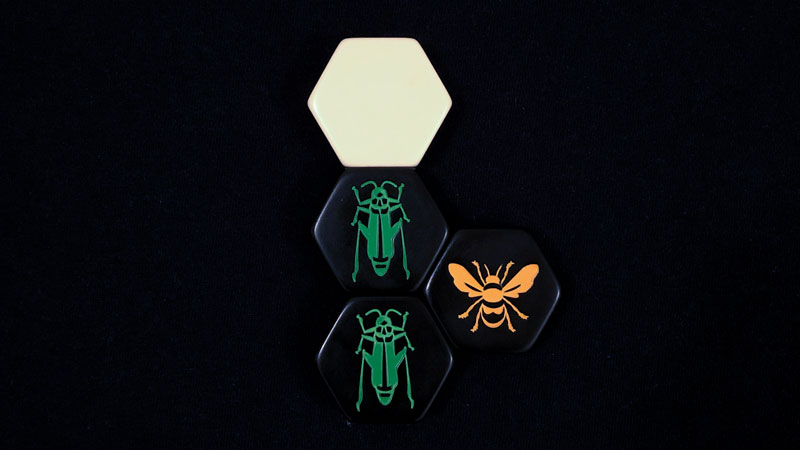
Grasshopper is placed first, followed by the Queen Bee and the second Grasshopper in a V shape placement.
I almost always use this strategy when it comes to playing with black bugs. It allows the Queen Bee to have a pair of very strong defenders next to her, waiting for the exact moment to jump out from the hive to screw up the opponent’s strategy.
The position of the grasshoppers in the hive also depends on the position of your opponent’s bugs. Grasshoppers are great defenders but they can be placed strategically to force the other player to move a certain bug to avoid the pin.
#5 | Grasshopper – Queen Bee – Spider
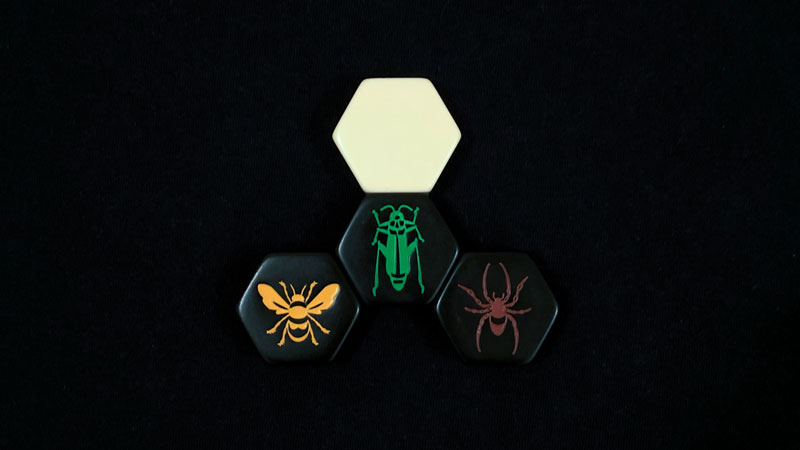
Grasshopper is placed first, followed by the Queen Bee and the Spider in a Y shape placement.
The difference with the strategy above is that this opening is much more offensive. The spider has the role of being an early treat for the opponent’s Queen Bee and to function as a spawn point on the other side of the Hive.
I like to use this strategy if I reckon that the spider could be used to pin fundamental opponent’s bugs such as Ants or the Queen Bee.
#6 | Grasshopper – Queen Bee – Ant
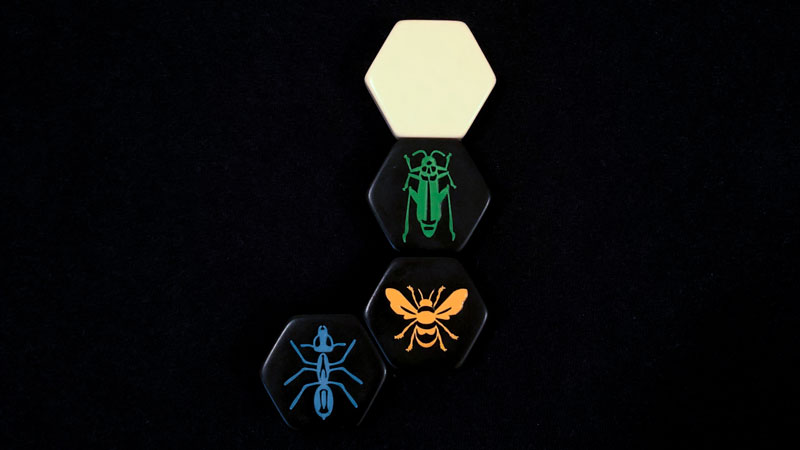
Grasshopper is placed first, followed by the Queen Bee and the Ant in an elbow shape placement.
Very similar to the #5 strategy, but here is way more offensive thanks to the Ant.
In fact, I place an Ant next to Queen Bee with the intention to make her move as soon as the opponent plays another strong bug, such as an Ant.
Placing an Ant in the early game is fundamental to take the first step in order to control the hive.